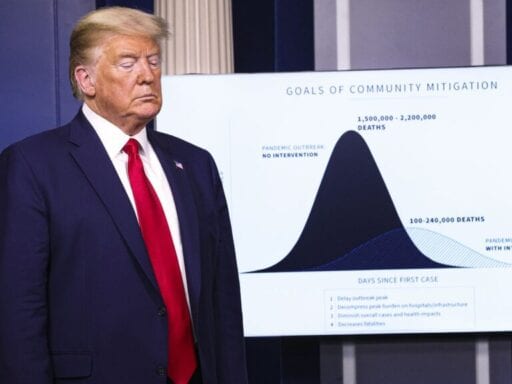At least. And outside experts say that’s a reasonable estimate.
On Tuesday, the White House’s coronavirus task force presented grim statistics: Under the best-case scenario for mitigation of the Covid-19 pandemic, there may be between 100,000 and 200,000 deaths in the United States, with the number of deaths peaking in the next two weeks. The White House’s numbers, presented in a sobering press conference, are based on statistical models drawing on the best available data that attempt to predict the number of cases and deaths.
“When you see 100,000 people — that’s a minimum number,” President Trump said during the press conference. That’s notable coming from Trump, who, in the early days of the outbreak, downplayed the threat and repeatedly compared it to the flu.
By Tuesday, it seemed the abundant evidence that Covid-19 is much worse than the flu had finally sunk in. “It’s not the flu; it’s vicious,” Trump said.
Dr. Anthony Fauci, the director of the National Institute of Allergy and Infectious Diseases, also emphasized that the outbreak and its toll are going to get worse before they get better. “As sobering a number as [100,000 deaths] is,” he said, “we should be prepared for it. Is it going to be that much? I hope not … We need to prepare ourselves — it is a possibility that that’s what we’ll see.”
Fauci said that the models that predict how the death toll will rise are based on data on how the outbreak is unfolding in New York and abroad. The estimates could change if the situation on the ground begins to look different. But the truth is that there are currently more than 180,000 cases of Covid-19 in the United States, and there have been more than 3,000 deaths. And its spread has clearly not yet peaked.
Dr. Deborah Birx, the White House coronavirus response coordinator, citing projections from the Institute for Health Metrics and Evaluation at the University of Washington, said deaths are expected to peak in the next two weeks. “This is going to be a very painful, very very painful two weeks,” Trump said.
/cdn.vox-cdn.com/uploads/chorus_asset/file/19863314/GettyImages_1208730774.jpg) Mandel Ngan/AFP via Getty Images
Mandel Ngan/AFP via Getty ImagesEpidemiological modeling is useful in helping the public think through what’s possible with the disease. It also can help hospitals understand how much staffing and equipment they’ll need (and where they are likely to fall short).
Independent experts say the models the task force is using are sound. “[100,000-200,000 deaths] certainly seem to be within the reasonable framework,” said Bill Hanage, associate professor of epidemiology at Harvard T.H. Chan School of Public Health, in a call with reporters Tuesday morning. “I would not be particularly surprised by them, I wouldn’t be surprised if they were higher, I wouldn’t be actually surprised if they were lower. One of the things that’s difficult for those of us who’ve been involved with modeling this is communicating the amounts of uncertainty that we have.”
Modeling is not an ironclad prediction of the future. “Unlike the weather, which we’re all accustomed to and incorporating forecasts into decision making, with pandemics we actually influence the outcome,” Caitlin Rivers, a professor at Johns Hopkins Center for Health Security, told Vox. Collective actions — continuing to social distance, self-isolating if you’re sick, supporting health care workers around the country, raising the capacity of the health care system — over the next few weeks will affect whether the models are updated for better or for worse.
“I think it’s key not to get fixated on the exact numbers,” Dominique Heinke, an epidemiologist who works with the Massachusetts Department of Public Health (who is not speaking on the behalf of the department), recently told Vox. “You can look at a range of models and say, we can expect it to be at least this bad.”
And the baseline numbers from the White House today are awful: 100,000-200,000 deaths is awful, especially because many could have been prevented with better screening and testing in February. Also, you don’t need models to see that the Covid-19 pandemic is a crisis: Thousands have died in the US. The economic crisis in the pandemic’s wake is crippling, too.
The stark numbers are also a reminder that we need to keep our interventions going. The outright lockdowns of movement in some cities, as well as the less severe policies in place across the country, can slow the spread of the pandemic.
The impacts of social distancing lag in case-count data and may take a few weeks to show up. Right now, there are infections out there, in the public, that were seeded long before these orders came into effect. It can take 10 days or more between when a person is infected and when they show symptoms — during which they can spread the virus to others.
“In the next several days to a week, we will continue to see things go up,” Fauci said Tuesday. “We cannot be discouraged by that — the mitigation is working and it will work.”
Author: Brian Resnick
Read More



